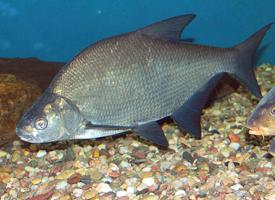
Animal description
The Eurasian carp, scientifically known as Cyprinus carpio, is a species of freshwater fish that is native to Asia and Eastern Europe. This species has been introduced to environments worldwide, where it often becomes an invasive species due to its robust nature and adaptability. The Eurasian carp is a significant part of the Cyprinidae family, which is notable for its diverse and numerous species.Eurasian carp typically have a large, robust body, with scales that can range in color from silvery-grey to golden brown, depending on their habitat and age. They possess a pair of barbels (whisker-like structures) on either side of their mouth, which are highly sensitive and aid in detecting food on the murky bottoms of water bodies. Their dorsal and anal fins are long and may have a slightly serrated appearance, which is characteristic of the species. The mouth of the Eurasian carp is protractile, allowing it to project forward to grasp food, an adaptation that enables it to feed on a variety of food sources.
One of the most adaptable and resilient fish species, Eurasian carp thrive in a wide range of freshwater habitats. They are commonly found in lakes, rivers, and ponds, showing a particular preference for slow-moving or standing waters with abundant vegetation. This preference is largely due to their feeding habits; Eurasian carp are omnivorous, feeding on a diet that includes plants, insects, crustaceans, and other small aquatic organisms. Their feeding behavior, which often involves rooting around in the sediment, can lead to increased water turbidity and the uprooting of aquatic plants, impacting water quality and the overall health of aquatic ecosystems.
Eurasian carp are known for their remarkable reproductive capabilities. They reach sexual maturity at a relatively young age and can produce a vast number of eggs during the spawning season, which typically occurs in the spring and early summer when water temperatures rise. This prolific breeding, combined with a lack of natural predators in introduced environments, allows their populations to increase rapidly and can lead to their dominance in certain ecosystems.
The introduction of Eurasian carp into non-native environments has often been met with ecological challenges. In many areas, their presence has led to significant ecological imbalances, outcompeting native species for food and habitat. Their habit of disturbing the sediment layer can also degrade water quality, affecting both aquatic life and human use of water resources.
Despite the ecological concerns associated with Eurasian carp, they have been valued by humans for centuries. They are one of the oldest species of fish cultivated by humans, with aquaculture practices dating back thousands of years in Asia and Europe. In many cultures, Eurasian carp are considered a delicacy and are farmed for food. Additionally, they are used in some areas for water quality management, as they can help control certain aquatic weeds and parasites.
In conclusion, the Eurasian carp (Cyprinus carpio) is a species of great adaptability and resilience. While it plays an important role in some human agricultural practices, its introduction into non-native environments poses significant ecological challenges. Managing its populations to prevent negative impacts on biodiversity and aquatic ecosystems remains a critical concern for conservationists and environmental managers worldwide.
Similar Animals
New photos of animals
Top 10 animals
- Elephant hawk moth (Deilephila elpenor)
- Common house mosquito (Culex pipiens)
- Common cockchafer (Melolontha melolontha)
- Australian box jelly (Chironex fleckeri)
- Fruit fly (Drosophila melanogaster)
- Wasp spider (Argiope bruennichi)
- Colossal squid (Mesonychoteuthis hamiltoni)
- Moustached guenon (Cercopithecus cephus)
- Diana monkey (Cercopithecus diana)
- Sea urchins (Echinoidea)


